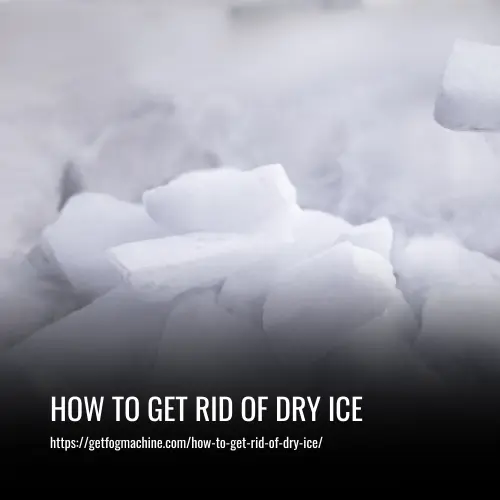How to Get Rid of Dry Ice: Safe Disposal Methods
This post contains affiliate links. As an Amazon Associate, we earn from qualifying purchases.

How to Get Rid of Dry Ice
When it comes to getting rid of dry ice, safety should be the top priority. Follow these step-by-step instructions to ensure a smooth and safe process.
Step 1: Select The Right Place And Time
Choose a well-ventilated area for disposing of dry ice. Open windows or do it in an outdoor space like a backyard or fire escape. Ensure children and pets cannot access the area. Pick a time when the weather is clear.
Step 2: Wear The Right Gear For Disposal
Protect yourself by wearing appropriate gear. Insulated gloves, such as oven mitts or winter gloves, are essential for handling dry ice. Also wear long sleeves, safety glasses, and closed-toe shoes to avoid direct contact with the dry ice.
Step 3: Letting Dry Ice Sublimate
With insulated gloves on, place the dry ice on a flat and well-ventilated surface. Allow it to sublimate or evaporate completely. Avoid staying in the area to prevent overexposure to carbon dioxide vapor.
Step 4: Let It Sit For Up To A Day
Allow the remaining dry ice to sit in the well-ventilated area for at least a day until it fully evaporates. If you have a large amount of dry ice that needs to be disposed of quickly, you can break it into smaller pieces or pour warm water over it, ensuring you wear your insulated gloves and safety glasses.
Step 5: Dispose Of The Equipment Correctly
Once the dry ice has completely evaporated into carbon dioxide gas, dispose of the equipment used properly. Gather the airtight container, protective gear, and the flat surface used for disposal. Place them in a plastic bag and dispose of them at a facility that accepts hazardous waste products.
Remember to always prioritize safety and proper ventilation when handling and disposing of dry ice.
How Long Does It Take for Dry Ice to Melt
Dry ice does not melt in the traditional sense. Instead, it undergoes sublimation, a process where it transitions directly from a solid to a gas without becoming a liquid. Sublimation occurs at a rate of approximately two percent per hour inside insulated containers. Larger blocks of dry ice can lose around five to ten pounds every 24 hours while in storage.
The rate of sublimation can vary based on factors such as the size and shape of the dry ice, as well as the ambient temperature. For example, smaller pellets of dry ice will sublimate faster than a solid block of the same weight.
In general, a two-pound brick of dry ice left exposed to sunlight at 30 degrees Celsius will completely sublimate in about 15 minutes. It’s important to note that these times can vary, and it is best to observe the dry ice as it undergoes sublimation rather than waiting for it to melt.
Safety Precautions For Handling Dry Ice
Dry ice, which is frozen carbon dioxide, can be dangerous if not handled properly. Whether you are disposing of dry ice or using it for various purposes, it is crucial to follow certain precautions to ensure safety. Here are some essential tips for handling dry ice:
1. Dispose Of Dry Ice In Well-Ventilated Areas
When disposing of dry ice, it is important to do so in a well-ventilated area. Carbon dioxide gas can build up and create an oxygen-deficient atmosphere, which can be dangerous to individuals in poorly ventilated spaces. Always dispose of dry ice in areas that are not accessible to the public, animals, or children.
2. Don’t Touch Dry Ice With Your Bare Skin
Dry ice is extremely cold, and direct contact with bare skin can cause frostbite or burns. It is crucial to wear insulated gloves and protective eyewear when handling dry ice to avoid any injuries. Ensure proper protection to avoid ice burns or other accidents.
3. Avoid Dumping Dry Ice In The Garbage Disposal
Do not dispose of dry ice in the garbage disposal, trash cans, sewers, or garbage chutes. An airtight space can cause carbon dioxide vapor buildup, leading to potentially dangerous situations or even explosions. Always dispose of dry ice in a well-ventilated area to prevent any mishaps.
4. Store Dry Ice Correctly
Dry ice should not be stored in a glass or airtight container. Use containers specifically designed for dry ice storage that allows for the release of carbon dioxide gas. Avoid placing dry ice directly on surfaces like tile or laminate countertops. The best option is to store dry ice in an insulated or Styrofoam cooler in a not frequently used room.
5. Transport Dry Ice With Adequate Ventilation
If you need to transport dry ice, ensure that your vehicle has adequate ventilation. Open one or more windows to allow the carbon dioxide gas emitted from the dry ice to escape. In a closed space, the gas can accumulate and cause disorientation or fainting, potentially leading to accidents.
6. Purchase Dry Ice Close To The Time Of Use
Dry ice sublimates, meaning it converts directly from a solid to a gas. It does not have a long shelf life, so it is best to purchase it closer to the time of use to ensure maximum freshness and effectiveness.
By following these precautions, you can safely handle and dispose of dry ice without any risks or incidents. Always prioritize safety and take appropriate measures when dealing with this hazardous substance.
FAQs
Pouring melted dry ice down the sink or toilet is not recommended. Dry ice does not melt but instead freezes the water in pipes, causing them to burst and potentially causing significant damage. If dry ice accidentally falls into a sink, it should be immediately flushed with hot water.
When warm water is added to a tightly sealed container or dry ice container, it generates a dense white fog. This fog is composed of tiny water droplets and is similar to mist or fog found in nature. The fog is created as the very cold dry ice sublimates from its solid state to a gaseous state.
Flushing dry ice down the drain can cause the ice to freeze running water, potentially leading to burst pipes and further damage. If dry ice is accidentally flushed, it is essential to pour hot water immediately to prevent additional plumbing and structural issues.
To quickly get rid of dry ice, it should be placed in a well-ventilated area at room temperature. Proper disposal allows the remaining dry ice to sublimate away.
Dry ice, which is solid carbon dioxide, is non-flammable. It is available in the form of flakes, pellets, or blocks and poses no combustion risk.
Breathing in dry ice can be harmful, particularly in high concentrations. Workers who handle dry ice or liquid nitrogen face health risks, including loss of consciousness and potential suffocation. It is crucial to handle dry ice in a well-ventilated area and follow safety precautions to avoid overexposure to carbon dioxide.
Leaving dry ice outside to melt is not recommended. Direct contact with dry ice can be hazardous, and the release of carbon dioxide gas can pose risks to people and animals around. Choose a well-ventilated outdoor area, away from hallways, shared spaces, and areas accessible to children and pets, to allow the dry ice to sublimate.
Dry ice itself is not toxic, but inhaling the carbon dioxide gas produced by dry ice can be harmful to health. It is crucial to store and handle dry ice in a well-ventilated environment to prevent overexposure to carbon dioxide.
Conclusion
Proper disposal of dry ice is crucial for safety and preventing damage. Attempting to melt dry ice by pouring it down the sink or toilet can lead to bursting pipes and costly repairs. Instead, it should be allowed to sublimate in a well-ventilated area at room temperature. Placing dry ice in hot water can expedite the sublimation process.
It is important to remember that dry ice should not be disposed of in trash cans or chemical containers. Additionally, dry ice is non-flammable and poses no combustion risk. However, overexposure to carbon dioxide gas can be dangerous, so it is important to handle dry ice with insulated gloves and in a well-ventilated environment.





